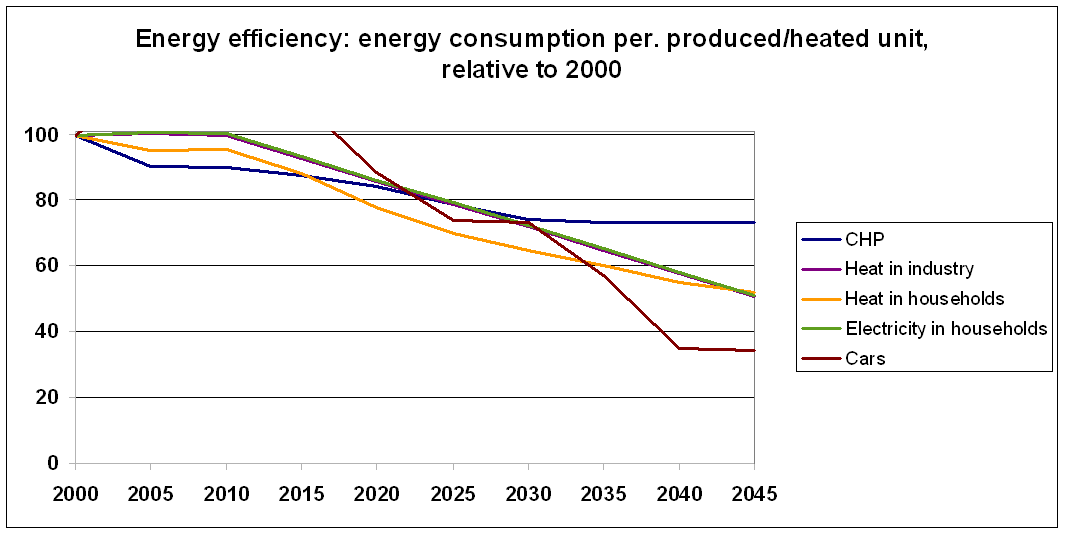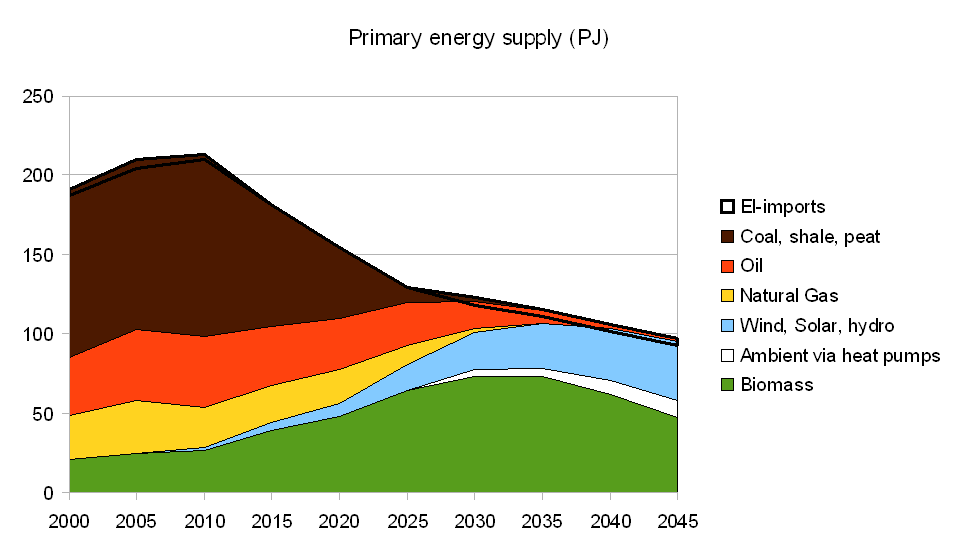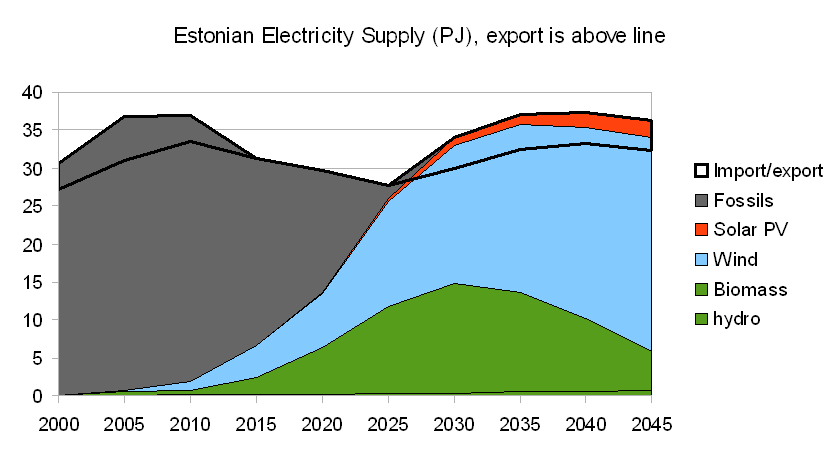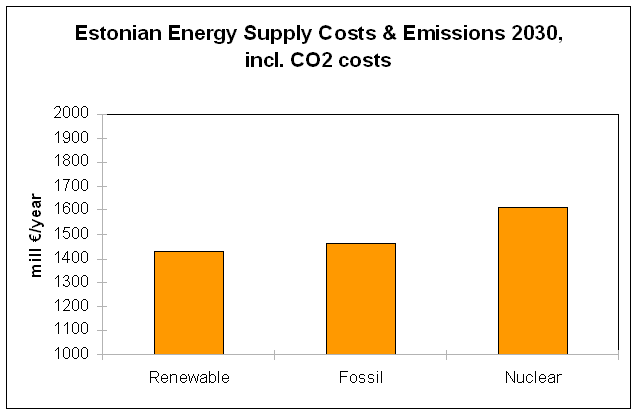| About Us | Contact Us | Member Database | Contact Database | Support Us |
Estonian Sustainable Energy Vision
 November
2011:
November
2011:
The Estonian
Sustainable Energy Vision is similar to the vision
for EU; but developed to fit the situation in Estonia.
The proposed development follows in general the same path as in the European vision, but given the large biomass and wind potentials, and the desire to reduce fossil fuel imports, the vision has a strong focus on actions to turn the current trend into reductions of fossil fuel use, also before 2020. This includes gradually replacing oil shale with biomass in the coming two decades. The scenario includes some growth in energy services for household, service and transport sectors, with all growth in transport in rail transport. The scenario includes a transition of the energy supply and demand with phase-out of fossil energy over a 25-30 year period, 2010 - 2040.
If this vision is turned into reality it will have a number of positive effects for Estonia. With a transition to domestic, renewable energy sources, Estonian will no longer be hurt directly by the energy prices increases of fossil fuels that many expect will come as a result of the dwindling resources of fossil fuels. With realisation of the vision, Estonia would also be in the front in the reduction of climate change, a position that can be very valuable in the future. Further, the emphasis on local resources will also benefit the economy with increased employment and a more positive trade balance. If Estonia is going to continue its development and growth, it has to be energy efficient.
To
show the positive effects in more details, an analysis is made of the
economic effects of the proposed transition until 2030, compared with
continued use of oil-shale and natural gas and compared with a scenario
with nuclear power.
See results below.
Increase in Energy Efficiency
In line with INFORSE’s global vision for sustainable energy, the
Estonian Vision is based on increase of energy efficiency.
A
number of studies have shown that with best available technology, on
the market or close to market introduction, it is possible to increase
energy efficiency with a factor four or more for most energy uses.
Most energy consuming equipments will be changed several times until
2040,
and if new generations of equipment are made with optimal energy performance,
and markets are made to promote the most efficient technology, it will
not be a problem to reach today's best available technology. This will
not happen by itself, given that the "natural" technological
development in EU countries has been about 1% per year. The development
of selected sectors is shown on the graph below.
The Challenge of Reducing Heat Consumption
For buildings the situation is different from equipment and vehicles
because buildings often have lifetimes of 100 years or more. Many
of the houses to be heated in 2050 are probably already built.
Statistics
indicates that efficiency of heating did improve some 2000 – 2008.
The need for large replacement or major renovation
of block houses build during the Soviet Union gives an opportunity
for large increases in efficiency, if appropriate standards and
support is
in place. Efforts
should be continued following EU regulation. This is expected
to be a combination of improved heating installations in houses
and improved
buildings. During the scenario the heating efficiency is expected
to be doubled, leading to a halving of the specific energy use
for heating (heat demand per m2).
Efficient Transport
For transport is assumed that the conversion-efficiency from fuel
to transport-work is doubled (except for aviation)
with more efficient cars and with transition to electric traction in rail
and road. This increase is expected to
happen until 2040. Most of the changes are only
expected after 2020. Some road transport will also be converted
to biogas and liquid biofuels, but only based on production in Estonia.

Graph: Development of energy efficiency expressed in development of specific energy demand compared with 2000 for one supply sector (CHP) and 4 end.use sectors.
An underlining assumption for this development is a generally stable population in Estonia.
Transition
to 100% renewable energy
The
results of the proposals for increasing renewable energy use, increase
in energy efficiency, and moderate growth of energy services lead to
the transition to renewable energy in about 30 years. One way of the
transition is expressed in the two graphs below:


The graphs show how the increased energy efficiency leads to reduced primary energy demands, but also to increased power consumption after 2020. when electric transport and heat pumps are introduced in the scenario.
The scenarios for transition to renewable energy of Estonia is described in details in this paper, March 2011 (pdf file, 900 kB)
Comparing
Fossil, Nuclear, and Renewable Scenarios
To evaluate the above scenario, INFORSE-Europe has compared the 100%
renewable energy scenario with continued use of fossil fuel (mainly
oil-shale and natural gas) and with a scenario with a nuclear power
plant in Estonia. The comparison is made for the situation in 2030,
when
still some fossil fuel is used in alls scenarios; but when the
power structure have been rebuilt according to the three scenarios.
The comparison
is made with modeling the energy system in 2030 hour by hour with
typical variations in consumption, wind power etc. The three scenarios
have the same energy efficiency and energy service assumptions, so
the comparison show only the effect of different energy supply systems.
As the graph
below
shows, the renewable scenario is the cheapest. Of course
the economic results depends on the assumptions, and if for instance
an accident happen with nuclear power, this scenario will be much
more expensive than in the present example.

Graph: Comparison of total costs in 2030 of three scenarios for Estonia. The costs include import and export of electricity, which is a cost for the fossil scenario (net import) and an income for the renewable and nuclear scenarios (net export). The CO2 costs are set to 18 €/ton.
Further explanations and comparisons, as well as the assumptions behind the modeling of the three scenarios are given in the this paper (pdf 180 kB), November 2011,
See also: Information in Estonian (13 pages, pdf file, 0.6 MB)
Estonian
The work on this paper and the sustainable energy vision for Estonia is partly paid by funding received from the Nordic Council of Ministers, and the European Commission; but it expresses the findings and the views of the authors and of INFORSE-Europe and not necessarily of the funders and the funders are not liable for use of the information.
![]()